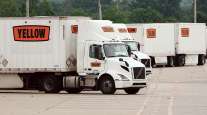Staff Reporter
E-Commerce Spike Likely to Outlast COVID-19 Pandemic, Experts Say

[Ensure you have all the info you need in these unprecedented times. Subscribe now.]
COVID-19 has accelerated the growth of e-commerce, a trajectory that could have significant implications for the trucking sector even after the pandemic passes.
“I think from the macroeconomic view, you have these big curves and step changes in life,” Glenn Koepke, vice president of network enablement at FourKites, told Transport Topics. “If you look at the last 10 or 20 years, obviously Amazon’s dominance has been one of those big curves in just overall logistics and supply chains. I do think COVID-19 will be that next curve.”
In the second quarter, at the height of the pandemic, e-commerce sales surged 44.5% to account for 16% of $1.31 trillion in total retail sales, the latest data from Department of Commerce shows. The total sales amount represents a 3.6% drop from a year ago as many businesses operated at limited capacity or completely ceased.
Logistyx Technologies President Ken Fleming said several of the changes in buying behavior will likely last beyond the pandemic. “E-commerce growth is great news for most trucking businesses, especially those supporting e-commerce order fulfillment, as delivery volume to distribution centers and directly to consumers keep rising.”
Koepke suspects there will be a change in how supply chain distribution happens as a result of this acceleration. He pointed to the possibility there will be a greater shift from truckload to less-than-truckload, but he doesn’t see that shift impacting truckload volumes.
“I think truckload volumes will stay,” Koepke said. “What we’re going to see though, maybe the length of hauls or the type of shipments start to change. So rather than ship to a grocery retailer, I might be shipping to an e-commerce middleman warehouse that is doing order fulfillment and distribution. I think where we’ll see the change is a rise in couriers.”
Meaning more final-mile deliveries.

Koepke
Koepke said that’s where a lot of innovation and new services will continue to evolve. “Let’s say they source from stores now and that omnichannel effect, they’re not going to be able to take in whole truckloads,” he said. “So overall, there’s a rise in LTL volumes and then a rise in traditional parcel, but then also this courier-type, ride-share models mode as well and that final-mile component.”
One lingering question, he said, is how much the acceleration in e-commerce will taper once there’s a coronavirus vaccine.
“E-commerce is likely to slow once social distancing is lifted,” said Bob Costello, chief economist at American Trucking Associations. “However, I suspect that some of the market share gains that e-commerce grabbed will remain with e-commerce.”

Costello
Costello believes that the bigger issue is households will go back to spending more on services once social distancing restrictions are lifted.
“Today, we are spending more on tangible goods than prior to the pandemic,” Costello said. “Households aren’t going to movies, traveling or spending money on concerts and sporting events. Many are taking those dollars and buying goods, which is helping trucking. Once people are confident going into large groups again, they will likely take funds for goods and move them back to services.”
The jump in online shopping this year has been significant. DHL International, the courier, parcel and express mail service, detailed in a logistics trends report Sept. 25 that global e-commerce sales are expected to exceed $4 trillion this year compared with $3 trillion in 2019.
DHL Supply Chain ranks No. 3 on the Transport Topics Top 50 list of the largest logistics companies in North America.
Online retail behemoth Amazon.com reported earnings nearly doubled in the second quarter. Net income increased to $5.2 billion compared with net income of $2.6 billion the year before, and revenue soared 40% to $88.9 billion in the quarter compared with $63.4 billion.
At mass retailer Walmart, revenue was $137.7 billion, an increase of $7.4 billion, or 5.6% in the fiscal second quarter. But U.S. e-commerce sales grew 97% across all channels. Net income was $6.5 billion compared with $3.6 billion the prior year.
Walmart ranks No. 3 on the Transport Topics Top 100 list of the largest private carriers in North America.
Likewise, Costco sales for its fiscal fourth quarter ended Aug. 30 increased 12.5% to $52.3 billion from $46.5 billion last year. But online sales were up 91%. Net income was $1.4 billion compared with $1.1 billion.
“Numerous retailers I have been speaking to have discussed how their online sales projections have been brought forward between three and five years,” Gartner Inc. analyst Thomas O’Connor told TT. “While there may be some retailers that see a slight pull back in overall online sales, the reality is online has clearly increased its share of the overall retail pie.”
U.S. e-commerce sales were just 10% of overall retail sales in the second quarter of 2019, the Commerce Department said.
Want more news? Listen to today's daily briefing:
Subscribe: Apple Podcasts | Spotify | Amazon Alexa | Google Assistant | More




